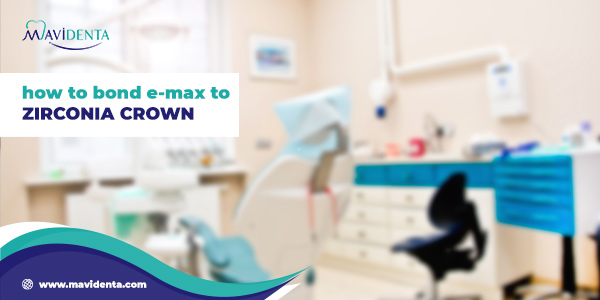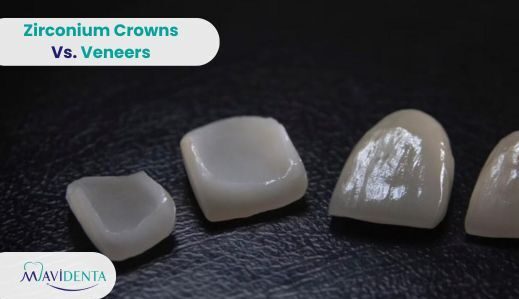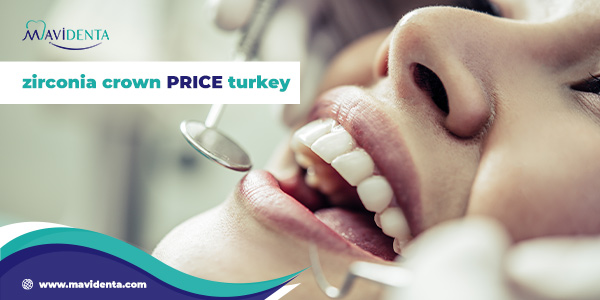Are you thinking of a dental restoration? What about bonding Zirconia crowns to E-max? How can you bond Zirconia crowns seamlessly by combining durability with a natural look? In this article, we will answer all these questions and explain more information about dental restorations that represent a flawless aesthetic smile.
Selecting the Right Adhesive for E-max to Zirconia Bonding:-
Selecting the right adhesive for bond zirconia crowns to emax is essential to ensure a durable and beautiful fusion, and it is considered an important part of how to bond E-max to Zirconia crown .
The choice of adhesive depends on how well it works with both materials, ensuring a strong and long-lasting bond while maintaining the natural appearance. This complex dental bonding process depends on a number of factors, including adhesive strength and biocompatibility.
Read more about Zirconia Crown Price Turkey
How to bond zirconia crowns and zirconia resin bonded bridges?
The method of bonding zirconia crowns and zirconia resin-bonded bridges is similar to how to bond Zirconia crown to emax . Adhesion of bonding zirconia crowns and zirconia resin-bonded bridges requires a proper technique to guarantee a strong and long-lasting bond. Follow us on the step-by-step guide:
1.Preparation:
The dentist should ensure that there is no debris on the zirconia crown or the surface of the tooth and he can use air and water sprays to get rid of any impurities.
2.Silane Application:
The internal surface of the zirconia crown should be lightly coated with a silane coupling agent. Silane facilitates the zirconia’s adherence to the resin cement.
3.Adhesive Placement:
The dentist should apply a layer of adhesive resin cement to the interior surface of the zirconia crown and ensure that it covers the whole bonding surface by distributing it equally.
4.Light Curing:
To polymerize the sticky resin, the dentist should use a curing light. He should also pay attention to the manufacturer’s directions regarding the proper curing intensity and time.
5.Cementation:
The dentist should apply a thin layer of resin cement to the tooth surface that has been prepared and make sure the zirconia crown is properly aligned and fits by gently putting it onto the tooth.
6.Excess Cement Removal:
The dentist should use floss or an explorer for removing any extra cement that may have formed around the edges. Excess cement can cause gum inflammation and other problems, so the dentist should be particularly careful to ensure that it is removed completely.
7.Final Curing:
To completely polymerize the resin cement, the dentist should use the curing light and make sure that the crown is fully cured and the bond is strong by paying close attention to every detail.
It is crucial to note that the specific bonding procedure may vary depending on the materials and items used. You should consult with your dentist and adhere to their instructions for the proper bonding technique for your specific case.
We highly recommend Mavidenta clinic, the Most Trust Dental Clinic in Istanbul. Get online consultation now!
How to choose between zirconia crowns and IPS e.max crowns?

Choosing between zirconia crowns and IPS E.max crowns requires careful consideration of various factors, unlike how to bond E-max to Zirconia crown . Here is a guide to help you make an informed decision:
Aesthetics:
Zirconia and IPS e.max crowns both provide very good aesthetic outcomes. However, IPS e.max crowns have the benefit of looking more translucent and similar to the natural teeth. For those who prioritize having a very natural and lifelike appearance, IPS e.max crowns might be the better option.
Strength and Durability:
Zirconia crowns are renowned for their remarkable strength and longevity. Because of their extreme resistance to chipping and cracking, they are appropriate for bruxism patients or those or those who require extensive chewing forces. While IPS e.max crowns are just as strong as zirconia crowns, they might be more prone to breaking.
Tooth Preparation:
Zirconia crowns generally require more tooth reduction because of their material properties. IPS e.max crowns, on the contrary, retain more of the natural tooth structure and enable more conservative preparations.
Restoration Placement:
Choosing between zirconia and IPS e.max can also depend on the location of the crown. While IPS e.max crowns are frequently used for anterior (front) teeth where esthetics play a major role, zirconia crowns are frequently advised for posterior teeth that experience significant biting and chewing forces.
Dentist’s Recommendation:
The advice and experience of your dentist are crucial when making decisions. They will take into account your specific case, discuss the benefits and drawbacks of each option, and help you in choosing the most suitable crown material according to your needs, oral health, and desired results.
It’s important to note that the bonding technique how to bond E-max to Zirconia crown is a different matter from choosing between zirconia crowns and IPS e.max crowns. In any way, your dentist will help you to determine the appropriate bonding protocol for your chosen crown material according to several factors such as aesthetics, strength, and tooth preparation.
Read more about Zirconia Crowns vs Porcelain Fused to Metal
What are the best cements for zirconia crowns and IPS e.max crowns?
Choosing the appropriate cement for zirconia crowns and IPS e.max crowns is essential for achieving a strong and reliable bond. Kindly check the following recommended cements for each type of crown:
Zirconia Crowns:
– Resin Cement: Resin-based cements, such as self-adhesive or dual-cure resin cements, are commonly used for bond zirconia crowns. They offer superior durability and bond strength. Examples involve RelyX Unicem, Panavia SA Cement, and Multilink Automix.
– Resin-Modified Glass Ionomer Cement (RMGI): RMGI cements are another proper option for zirconia crowns. They provide good adhesion and offer a secondary caries-preventive effect. Examples involve RelyX Luting Plus, Fuji Plus, and Ketac Cem Plus.
IPS e.max Crowns:
– Adhesive Resin Cement: IPS e.max crowns are usually bonded using adhesive resin cements. These cements offer excellent bond strength and esthetics. Examples involve Variolink Esthetic, RelyX Ultimate, and Calibra.
– Self-Adhesive Resin Cement: Some self-adhesive resin cements can also be used with IPS e.max crowns. These cements make bonding easier by removing the requirement for applying separate adhesive. Examples involve RelyX Unicem, Maxcem Elite, and SmartCem2.
It is crucial to remember that the type of cement chosen may vary depending on the type of crown. Therefore, your dentist will recommend the most suitable cement according to your case.
How to bond E-max to Zirconia crown are typically used as a separate type of restoration. Bonding procedures and materials may differ when bonding these crowns together. Your dentist will determine the appropriate bonding technique based on the personalized case and materials being used.
Read more about Zirconiaa vs Gold Crown: Which is the Best for Your Teeth?
Zirconia vs IPS e.max: which is better?
When comparing zirconia and IPS e.max, it’s important to note that both materials have their own unique strengths and considerations. Individual factors, such as the patient’s particular needs, aesthetic preferences, and functional requirements, will determine which option is best. To help you understand the characteristics of each material, consider the following comparison:
Zirconia:
– Strength and Durability: Zirconia is well known for having extraordinary strength and durability. It is considered a proper solution for patients with bruxism or those who exert significant biting forces because of its exceptional resistance to chipping and cracking.
– Aesthetics: Although zirconia crowns can have very good aesthetics, they are less transparent than IPS e.max crowns. For posterior teeth that need more strength than high translucency, they might be a better option.
– Tooth Preparation: Because of the nature of the material, zirconia crowns frequently necessitate more tooth reduction. If maintaining the integrity of your teeth is important to you, you might want to think about this.
The step of tooth preparation is also essential to do it within the steps of how to bond e.max to a zirconia crown with the application of different methods.
– Biocompatibility: Because zirconia is biocompatible and the body tolerates it well, there is a lower chance of tissue irritation or allergic reactions.
– Indications: For posterior teeth or cases where strength and durability are crucial, like in patients with high occlusal forces, zirconia crowns are frequently used.
Also check: Difference Between Zirconia And Porcelain Crowns
IPS e.max:
– Aesthetics: Because of their high translucency and ability to mimic the optical characteristics of natural enamel, IPS e.max crowns provide exceptional aesthetics, closely resembling natural teeth.
– Strength and Durability: Even though IPS e.max is strong, it might be more prone to fracture than zirconia, particularly in cases of heavy occlusal forces or parafunctional habits.
– Tooth Preparation: More natural tooth structure can be preserved with more conservative tooth preparations when using IPS e.max crowns.
– Indications: IPS e.max crowns are commonly used for anterior teeth or cases where achieving ideal aesthetics is a major concern, such as in smile makeovers.
The decision between IPS e.max and zirconia ultimately comes down to the unique requirements, preferences, and clinical factors of each patient. In order to achieve the desired result for your dental restoration, your dentist will carefully assess your case, go over the benefits and drawbacks of each material, and make a recommendation for the best option.
Call Mavidenta clinic now and get top-notch services at affordable prices!
Also check: Zirconium Veneers Price Turkey: Ultimate Guide
How to bond zirconia crowns to emax?
Bonding e.max to a zirconia crown requires specific techniques and materials to ensure a strong and reliable bond. Here’s a general guide on how to bond zirconia crowns to emax:
Surface Preparation:
Your dental professional can start by cleaning the e.max crown’s exterior and the zirconia crown’s interior surfaces and use of an alcohol solution or dental detergent to eliminate any impurities or leftovers.
Silane Application:
The dental professional can apply a thin coating of silane coupling agent to the internal surface of the zirconia crown. Silane strengthens the bond between the resin cement used for bonding and the zirconia.
Adhesive Resin Cement:
The dental professional can select a resin cement that is appropriate for zirconia and e.max bonding; preferably, it has instructions specifically for zirconia bonding. Additionally, he should ensure that adhesive resin cement is evenly applied to the interior surface of the e.max crown.
Light Curing:
The adhesive resin cement inside the e.max crown can be partially cured with a curing light. Regarding the suggested curing time and intensity, your dentist should adhere to the manufacturer’s instructions.
Cementation:
Cementation is a crucial step involving precise techniques to ensure a strong and durable bond between the restoration and the tooth structure. The dentist, after the preparation step of the tooth, can apply a thin layer of resin cement.
It is necessary that the dentist should check that the e.max crown fits and aligns correctly by seating it onto the tooth and to prevent any issues, excess cement should be removed immediately.
Final Curing:
Final curing is an essential step to guarantee that the restoration reaches its optimal strength and properties, allowing patients to resume normal function and use of the treated tooth.
The dentist uses and applies the light for a specific duration according to the manufacturer’s recommendations to completely polymerize the resin cement. Then, he checks the crown to make sure that it is fully cured and the bond is strong by paying close attention to every detail.
It’s important to note that the particular bonding procedures can change based on the products and materials utilized. Furthermore, certain dental laboratories might offer particular guidelines or recommendations for bond zirconia crowns to emax.
Therefore, it is essential to consult with your dentist and follow their guidance, as they will have the most up-to-date knowledge and experience to ensure a successful bond between e.max and zirconia.
Explore the Best Dental Implant Clinic in Istanbul.
How to prepare teeth for zirconia crowns and IPS e.max crowns?

There are particular steps the dentist should take when preparing teeth for zirconia crowns and IPS e.max crowns to guarantee the best fit and long-term success. Here is a guide on how to prepare teeth for these crowns:
Anesthesia:
To guarantee the patient’s comfort throughout the tooth preparation procedure, the dentist should administer local anesthesia.
Tooth Reduction:
The dentist will use diamond burs to carefully remove the required amount of tooth structure. For zirconia crowns, a greater reduction is typically required compared to IPS e.max crowns due to the material’s strength.
Margin Placement:
It is necessary that the dentist creates well-defined margins at the appropriate location, ensuring a smooth transition between the prepared tooth and the crown margin. The margin placement will depend on the specific case and the clinician’s judgment.
Finish Line Design:
Depending on the material and intended use, the dentist selects the right finish line design such as feather-edge, shoulder, or chamfer and he checks that the crown material is properly cleared, taking the manufacturer’s recommendations into account.
Impression Making:
In this step, the dentist takes an exact impression of the prepared tooth by using an elastomeric material and he should make sure to capture all of the fine details and margins.
Bite Registration:
The dentist should ensure that the patient accurately registers his bite to guarantee appropriate occlusion and alignment of the final crown restoration.
We mentioned the preparation step by step. However, after the preparation stage, the dentist will determine the appropriate bonding protocol based on the specific crown material and patient’s case. We also mentioned above the steps of how to bond E-max to Zirconia crown.
Explore the Emax Dental Crown Price
Long-Term Stability: Factors Affecting E-max to Zirconia Bond:-
Achieving long-term stability in the bond between IPS e.max and zirconia crowns based on several factors. Kindly check the following considerations:
Surface Treatment:
It is critical that the zirconia and e.max surfaces be properly treated. So, the dentist should clean the zirconia surface, then sandblast and treat it with a primer or silane coupling agent to improve bonding. The dentist has also to etch the e.max surface and apply a bonding agent that works with both materials.
Cement Selection:
The longevity of the bond is significantly influenced by the cement selection. It is recommended to use resin cements designed especially for zirconia and e.max bonding. Over time, these cements offer excellent adhesion and durability.
Cement Thickness:
Applying an appropriate thickness of cement is essential. A cement that is too much can weaken the bond, while a cement that is too little can cause insufficient retention. Regarding the recommended cement thickness, the dentist should adhere to the manufacturer’s instructions.
Cement Polymerization:
For a strong bond, the cement must polymerize sufficiently. So, the dentist should make sure that the cement is properly cured, either chemically or by light in order to achieve ideal strength and stability,
Occlusal Adjustment:
Precise occlusal adjustment guarantees appropriate biting force distribution, reducing the risk of bond failure. You should follow the Regular check-ups and adjustments at the dentist’s clinic, if necessary, can promote long-term stability.
It is important that the dentist adhere to certain bonding protocols and material recommendations is necessary to achieve a stable bond between e.max and zirconia crowns.
Your dentist will have the expertise and skills to recommend the appropriate bonding procedure, ensuring the long-term stability of the bond between these materials. You can also check the above-mentioned steps on how to bond E-max to Zirconia crown .
Read more about Dental Implant Cleaning Cost
How to adjust and polish zirconia crowns and IPS e.max crowns?
- To achieve optimal aesthetics and functional harmony, specific techniques are needed when adjusting and polishing zirconia and IPS e.max crowns. Utilizing diamond or carbide burs made especially for ceramic materials is crucial when adjusting these crowns.
- The dentist should take precautions to prevent overheating, which could harm the crown. In order to guarantee correct bite alignment, the dentist should carefully evaluate and adjust occlusion needs.
- After adjustments, the dentist can carry out a series of polishing procedures. Initially, he can use coarse diamond-impregnated rubber wheels or porcelain polishing burs to refine the surface.
- Then, he can do a smooth and glossy finish by using diamond polishing pastes or finer grit polishing wheels. For zirconia and IPS e.max crown polishing, the dentist should adhere to the manufacturer’s instructions and recommendation in order to achieve the best results and preserve the integrity of the restoration.
- Regular professional maintenance and polishing can keep these crowns looking beautiful and lasting longer. Consulting with your dentist is necessary for proper adjustment and polishing procedures specific to your case.
- Our patients had a great experience at our clinic, Mavidenta and they recommend us to others. Contact us now.. we are glad to help you.
- In conclusion, how to bond E-max to Zirconia crown requires careful surface preparation, appropriate selection of compatible materials, and precise bonding techniques. To achieve a strong and long-lasting bond, the right adhesive resin cement, accurate light curing, and the use of a silane coupling agent are necessary.
Read more about Dental Implants Problems Side Effects
FAQs
Which type of cement should be used for bonding E-max to a zirconia crown?
It is necessary to use a resin cement specifically formulated for bonding E-max and zirconia. These cements provide optimal adhesion and durability.
How should the cement be applied during the bonding process?
The dentist should apply a thin layer of resin cement to the internal surface of the zirconia crown, ensuring even coverage. Additionally, he should apply a thin layer of cement to the prepared tooth surface. The dentist must follow the manufacturer’s guidelines for the recommended cement thickness and application technique.
Are there any additional steps or precautions to consider during the bonding process?
The dentist should carefully seat the crown onto the prepared tooth, ensuring proper alignment and fit. Prompt removal of excess cement and thorough cleaning of the restoration are essential to prevent complications.








